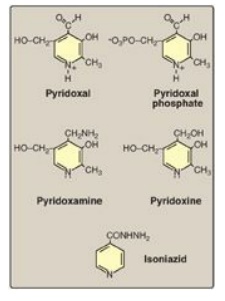Pyridoxine (Vitamin B6)
| Home | | Biochemistry |Chapter: Biochemistry : Vitamins
Vitamin B6 is a collective term for pyridoxine, pyridoxal, and pyridoxamine, all derivatives of pyridine.
PYRIDOXINE (VITAMIN B6)
Vitamin B6
is a collective term for pyridoxine, pyridoxal, and pyridoxamine, all derivatives
of pyridine. They differ only in the nature of the functional group attached to
the ring (Figure 28.10). Pyridoxine occurs primarily in plants, whereas
pyridoxal and pyridoxamine are found in foods obtained from animals. All three
compounds can serve as precursors of the biologically active coenzyme,
pyridoxal phosphate (PLP). PLP functions as a coenzyme for a large number of
enzymes, particularly those that catalyze reactions involving amino acids, for
example, in the synthesis of cysteine from Hcy. [Note: PLP is also required by
glycogen phosphorylase.]

Figure 28.10 Structures of
vitamin B6 and the antituberculosis drug isoniazid.
Reaction type - Example
Transamination : Oxaloacetate + glutamate ↔
aspartate + α- ketoglutarate
Deamination : Serine → pyruvate + NH3
Decarboxylation : Histidine → histamine + CO2
Condensation : Glycine + succinyl CoA → δ-aminolevulinic acid
A. Clinical indications for pyridoxine
Isoniazid, a drug
commonly used to treat tuberculosis, can induce a vitamin B6 deficiency
by forming an inactive derivative with PLP. Dietary supplementation with B 6 is,
thus, an adjunct to isoniazid treatment. Otherwise, dietary deficiencies in
pyridoxine are rare but have been observed in newborn infants fed formulas low
in B6, in women taking oral contraceptives, and in alcoholics.
B. Toxicity of pyridoxine
Pyridoxine is the only
water-soluble vitamin with significant toxicity. Neurologic symptoms (sensory
neuropathy) occur at intakes above 500 mg/day, an amount nearly 400 times the
Recommended Dietary Allowance (RDA) and over 5 times the Tolerable Upper Limit
(UL). Substantial improvement, but not complete recovery, occurs when the
vitamin is discontinued.
